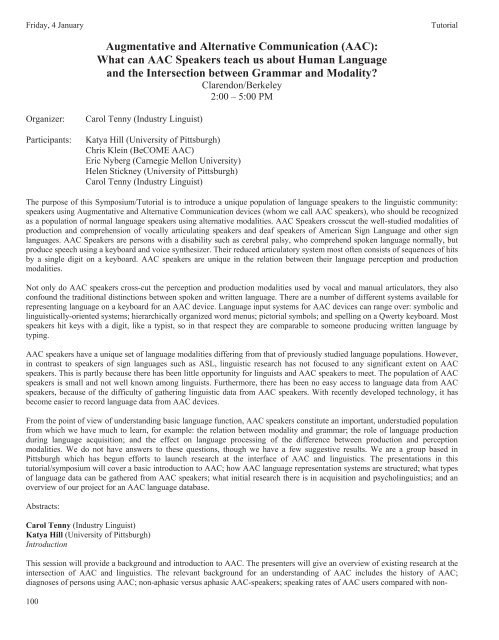here - Linguistic Society of America
here - Linguistic Society of America
here - Linguistic Society of America
You also want an ePaper? Increase the reach of your titles
YUMPU automatically turns print PDFs into web optimized ePapers that Google loves.
Friday, 4 JanuaryTutorialAugmentative and Alternative Communication (AAC):What can AAC Speakers teach us about Human Languageand the Intersection between Grammar and Modality?Clarendon/Berkeley2:00 – 5:00 PMOrganizer:Participants:Carol Tenny (Industry Linguist)Katya Hill (University <strong>of</strong> Pittsburgh)Chris Klein (BeCOME AAC)Eric Nyberg (Carnegie Mellon University)Helen Stickney (University <strong>of</strong> Pittsburgh)Carol Tenny (Industry Linguist)The purpose <strong>of</strong> this Symposium/Tutorial is to introduce a unique population <strong>of</strong> language speakers to the linguistic community:speakers using Augmentative and Alternative Communication devices (whom we call AAC speakers), who should be recognizedas a population <strong>of</strong> normal language speakers using alternative modalities. AAC Speakers crosscut the well-studied modalities <strong>of</strong>production and comprehension <strong>of</strong> vocally articulating speakers and deaf speakers <strong>of</strong> <strong>America</strong>n Sign Language and other signlanguages. AAC Speakers are persons with a disability such as cerebral palsy, who comprehend spoken language normally, butproduce speech using a keyboard and voice synthesizer. Their reduced articulatory system most <strong>of</strong>ten consists <strong>of</strong> sequences <strong>of</strong> hitsby a single digit on a keyboard. AAC speakers are unique in the relation between their language perception and productionmodalities.Not only do AAC speakers cross-cut the perception and production modalities used by vocal and manual articulators, they alsoconfound the traditional distinctions between spoken and written language. T<strong>here</strong> are a number <strong>of</strong> different systems available forrepresenting language on a keyboard for an AAC device. Language input systems for AAC devices can range over: symbolic andlinguistically-oriented systems; hierarchically organized word menus; pictorial symbols; and spelling on a Qwerty keyboard. Mostspeakers hit keys with a digit, like a typist, so in that respect they are comparable to someone producing written language bytyping.AAC speakers have a unique set <strong>of</strong> language modalities differing from that <strong>of</strong> previously studied language populations. However,in contrast to speakers <strong>of</strong> sign languages such as ASL, linguistic research has not focused to any significant extent on AACspeakers. This is partly because t<strong>here</strong> has been little opportunity for linguists and AAC speakers to meet. The population <strong>of</strong> AACspeakers is small and not well known among linguists. Furthermore, t<strong>here</strong> has been no easy access to language data from AACspeakers, because <strong>of</strong> the difficulty <strong>of</strong> gathering linguistic data from AAC speakers. With recently developed technology, it hasbecome easier to record language data from AAC devices.From the point <strong>of</strong> view <strong>of</strong> understanding basic language function, AAC speakers constitute an important, understudied populationfrom which we have much to learn, for example: the relation between modality and grammar; the role <strong>of</strong> language productionduring language acquisition; and the effect on language processing <strong>of</strong> the difference between production and perceptionmodalities. We do not have answers to these questions, though we have a few suggestive results. We are a group based inPittsburgh which has begun efforts to launch research at the interface <strong>of</strong> AAC and linguistics. The presentations in thistutorial/symposium will cover a basic introduction to AAC; how AAC language representation systems are structured; what types<strong>of</strong> language data can be gat<strong>here</strong>d from AAC speakers; what initial research t<strong>here</strong> is in acquisition and psycholinguistics; and anoverview <strong>of</strong> our project for an AAC language database.Abstracts:Carol Tenny (Industry Linguist)Katya Hill (University <strong>of</strong> Pittsburgh)IntroductionThis session will provide a background and introduction to AAC. The presenters will give an overview <strong>of</strong> existing research at theintersection <strong>of</strong> AAC and linguistics. The relevant background for an understanding <strong>of</strong> AAC includes the history <strong>of</strong> AAC;diagnoses <strong>of</strong> persons using AAC; non-aphasic versus aphasic AAC-speakers; speaking rates <strong>of</strong> AAC users compared with non-100
















